Financial Accounting Standards and West Ltd Case Study Report
VerifiedAdded on 2021/02/19
|9
|2398
|14
Report
AI Summary
This report provides an executive summary and detailed analysis of financial accounting standards relevant to West Ltd, a company selling canned and frozen fish products. The study focuses on AASB 136 (Impairment of Assets) and AASB 138 (Intangible Assets), examining their implications in the context of West Ltd's acquisition of Fishy Tales Ltd and the use of the ship 'Steve Irwin'. The report discusses the importance of accounting standards in ensuring financial transparency and reliability, and provides recommendations regarding the accounting treatment of the ship and its potential impairment. The analysis includes the relevance of goodwill, impairment losses, and the proper capitalization of repair costs. The report concludes by emphasizing the importance of adhering to accounting standards for informed financial decision-making and stakeholder trust.

Financial Accounting
Paraphrase This Document
Need a fresh take? Get an instant paraphrase of this document with our AI Paraphraser
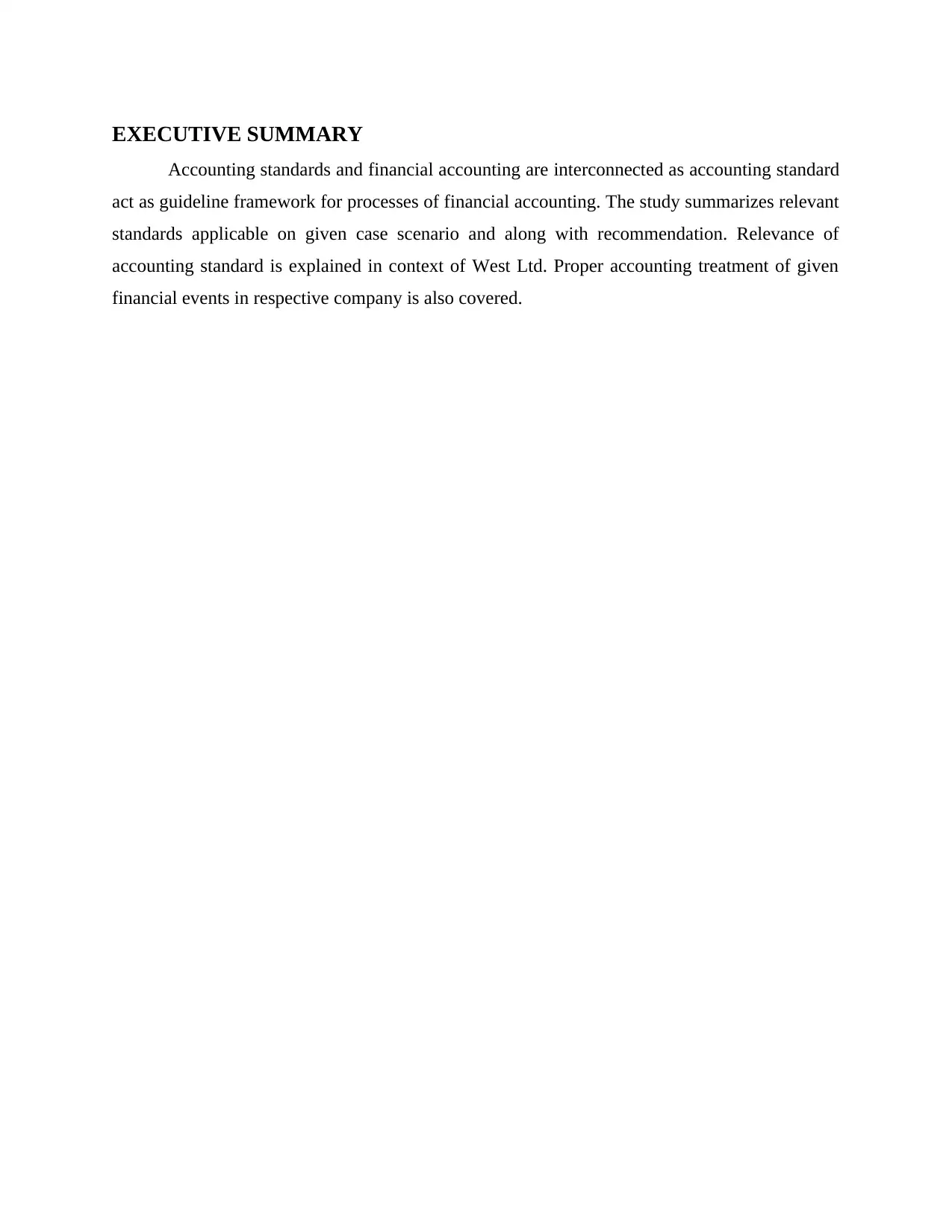
EXECUTIVE SUMMARY
Accounting standards and financial accounting are interconnected as accounting standard
act as guideline framework for processes of financial accounting. The study summarizes relevant
standards applicable on given case scenario and along with recommendation. Relevance of
accounting standard is explained in context of West Ltd. Proper accounting treatment of given
financial events in respective company is also covered.
Accounting standards and financial accounting are interconnected as accounting standard
act as guideline framework for processes of financial accounting. The study summarizes relevant
standards applicable on given case scenario and along with recommendation. Relevance of
accounting standard is explained in context of West Ltd. Proper accounting treatment of given
financial events in respective company is also covered.

Table of Contents
EXECUTIVE SUMMARY.............................................................................................................2
INTRODUCTION...........................................................................................................................4
TASK...............................................................................................................................................4
I. AASB 136: Impairment of Assets:...........................................................................................5
II. AASB 138 Intangible Assets:.................................................................................................6
RECOMMENDATION...................................................................................................................7
CONCLUSION................................................................................................................................8
REFERENCES................................................................................................................................9
EXECUTIVE SUMMARY.............................................................................................................2
INTRODUCTION...........................................................................................................................4
TASK...............................................................................................................................................4
I. AASB 136: Impairment of Assets:...........................................................................................5
II. AASB 138 Intangible Assets:.................................................................................................6
RECOMMENDATION...................................................................................................................7
CONCLUSION................................................................................................................................8
REFERENCES................................................................................................................................9
⊘ This is a preview!⊘
Do you want full access?
Subscribe today to unlock all pages.

Trusted by 1+ million students worldwide
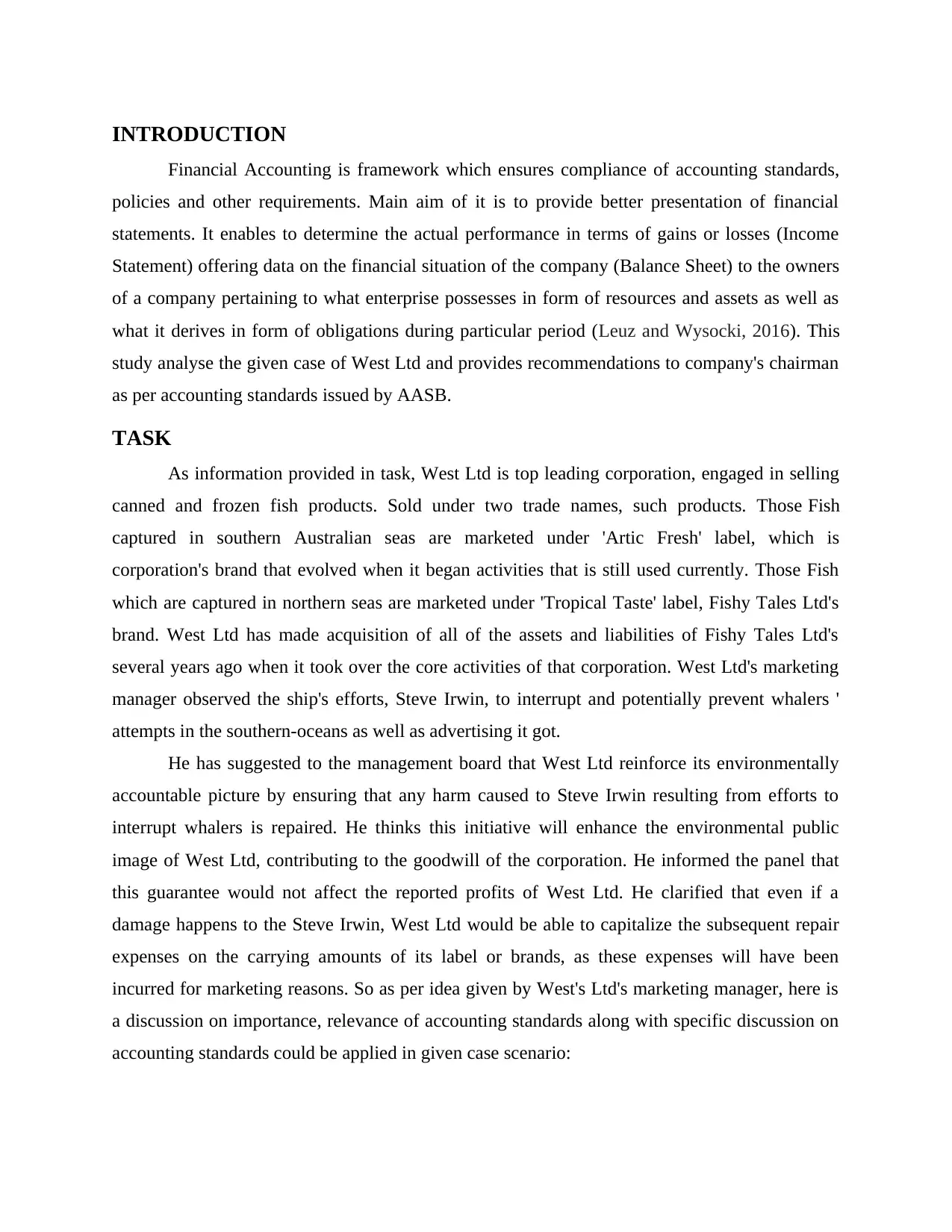
INTRODUCTION
Financial Accounting is framework which ensures compliance of accounting standards,
policies and other requirements. Main aim of it is to provide better presentation of financial
statements. It enables to determine the actual performance in terms of gains or losses (Income
Statement) offering data on the financial situation of the company (Balance Sheet) to the owners
of a company pertaining to what enterprise possesses in form of resources and assets as well as
what it derives in form of obligations during particular period (Leuz and Wysocki, 2016). This
study analyse the given case of West Ltd and provides recommendations to company's chairman
as per accounting standards issued by AASB.
TASK
As information provided in task, West Ltd is top leading corporation, engaged in selling
canned and frozen fish products. Sold under two trade names, such products. Those Fish
captured in southern Australian seas are marketed under 'Artic Fresh' label, which is
corporation's brand that evolved when it began activities that is still used currently. Those Fish
which are captured in northern seas are marketed under 'Tropical Taste' label, Fishy Tales Ltd's
brand. West Ltd has made acquisition of all of the assets and liabilities of Fishy Tales Ltd's
several years ago when it took over the core activities of that corporation. West Ltd's marketing
manager observed the ship's efforts, Steve Irwin, to interrupt and potentially prevent whalers '
attempts in the southern-oceans as well as advertising it got.
He has suggested to the management board that West Ltd reinforce its environmentally
accountable picture by ensuring that any harm caused to Steve Irwin resulting from efforts to
interrupt whalers is repaired. He thinks this initiative will enhance the environmental public
image of West Ltd, contributing to the goodwill of the corporation. He informed the panel that
this guarantee would not affect the reported profits of West Ltd. He clarified that even if a
damage happens to the Steve Irwin, West Ltd would be able to capitalize the subsequent repair
expenses on the carrying amounts of its label or brands, as these expenses will have been
incurred for marketing reasons. So as per idea given by West's Ltd's marketing manager, here is
a discussion on importance, relevance of accounting standards along with specific discussion on
accounting standards could be applied in given case scenario:
Financial Accounting is framework which ensures compliance of accounting standards,
policies and other requirements. Main aim of it is to provide better presentation of financial
statements. It enables to determine the actual performance in terms of gains or losses (Income
Statement) offering data on the financial situation of the company (Balance Sheet) to the owners
of a company pertaining to what enterprise possesses in form of resources and assets as well as
what it derives in form of obligations during particular period (Leuz and Wysocki, 2016). This
study analyse the given case of West Ltd and provides recommendations to company's chairman
as per accounting standards issued by AASB.
TASK
As information provided in task, West Ltd is top leading corporation, engaged in selling
canned and frozen fish products. Sold under two trade names, such products. Those Fish
captured in southern Australian seas are marketed under 'Artic Fresh' label, which is
corporation's brand that evolved when it began activities that is still used currently. Those Fish
which are captured in northern seas are marketed under 'Tropical Taste' label, Fishy Tales Ltd's
brand. West Ltd has made acquisition of all of the assets and liabilities of Fishy Tales Ltd's
several years ago when it took over the core activities of that corporation. West Ltd's marketing
manager observed the ship's efforts, Steve Irwin, to interrupt and potentially prevent whalers '
attempts in the southern-oceans as well as advertising it got.
He has suggested to the management board that West Ltd reinforce its environmentally
accountable picture by ensuring that any harm caused to Steve Irwin resulting from efforts to
interrupt whalers is repaired. He thinks this initiative will enhance the environmental public
image of West Ltd, contributing to the goodwill of the corporation. He informed the panel that
this guarantee would not affect the reported profits of West Ltd. He clarified that even if a
damage happens to the Steve Irwin, West Ltd would be able to capitalize the subsequent repair
expenses on the carrying amounts of its label or brands, as these expenses will have been
incurred for marketing reasons. So as per idea given by West's Ltd's marketing manager, here is
a discussion on importance, relevance of accounting standards along with specific discussion on
accounting standards could be applied in given case scenario:
Paraphrase This Document
Need a fresh take? Get an instant paraphrase of this document with our AI Paraphraser
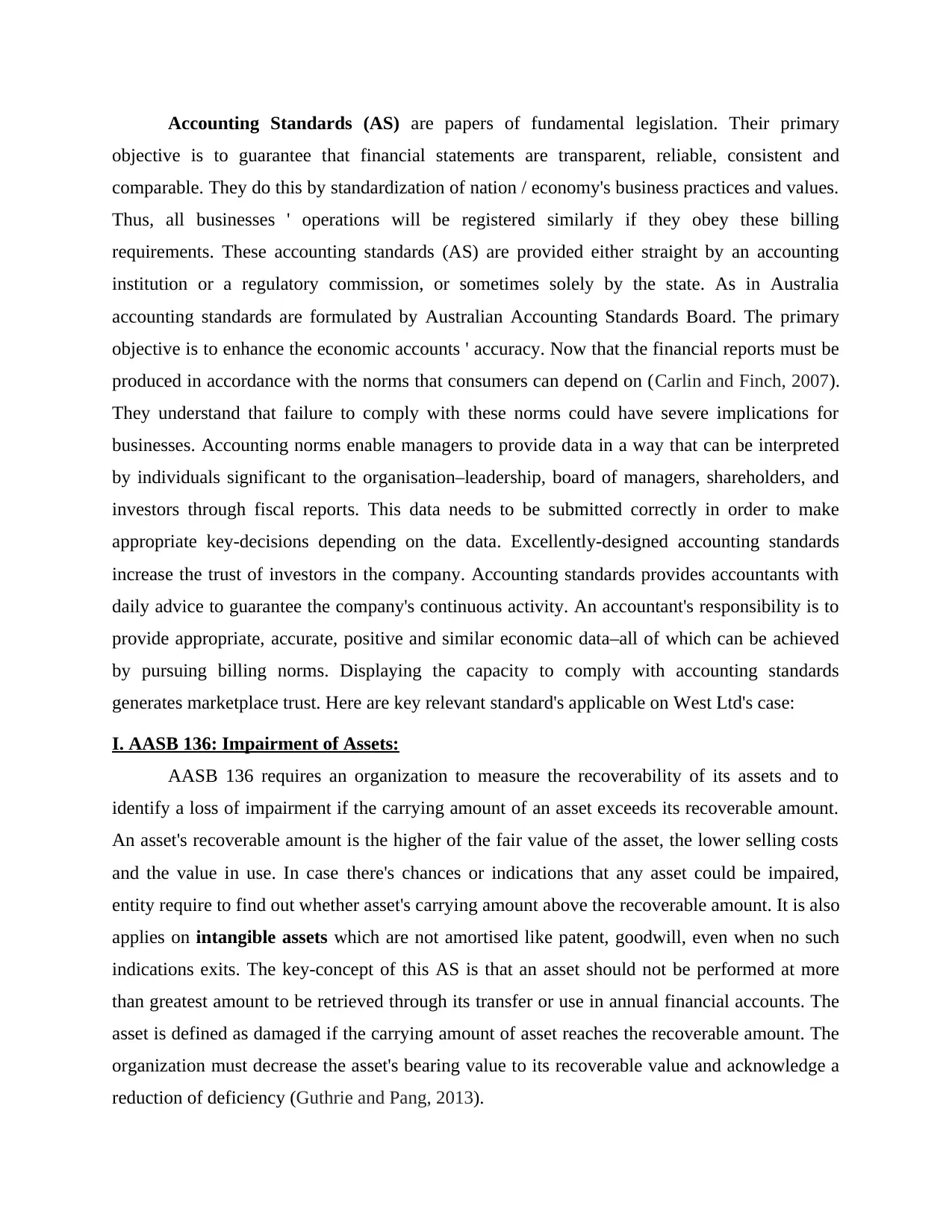
Accounting Standards (AS) are papers of fundamental legislation. Their primary
objective is to guarantee that financial statements are transparent, reliable, consistent and
comparable. They do this by standardization of nation / economy's business practices and values.
Thus, all businesses ' operations will be registered similarly if they obey these billing
requirements. These accounting standards (AS) are provided either straight by an accounting
institution or a regulatory commission, or sometimes solely by the state. As in Australia
accounting standards are formulated by Australian Accounting Standards Board. The primary
objective is to enhance the economic accounts ' accuracy. Now that the financial reports must be
produced in accordance with the norms that consumers can depend on (Carlin and Finch, 2007).
They understand that failure to comply with these norms could have severe implications for
businesses. Accounting norms enable managers to provide data in a way that can be interpreted
by individuals significant to the organisation–leadership, board of managers, shareholders, and
investors through fiscal reports. This data needs to be submitted correctly in order to make
appropriate key-decisions depending on the data. Excellently-designed accounting standards
increase the trust of investors in the company. Accounting standards provides accountants with
daily advice to guarantee the company's continuous activity. An accountant's responsibility is to
provide appropriate, accurate, positive and similar economic data–all of which can be achieved
by pursuing billing norms. Displaying the capacity to comply with accounting standards
generates marketplace trust. Here are key relevant standard's applicable on West Ltd's case:
I. AASB 136: Impairment of Assets:
AASB 136 requires an organization to measure the recoverability of its assets and to
identify a loss of impairment if the carrying amount of an asset exceeds its recoverable amount.
An asset's recoverable amount is the higher of the fair value of the asset, the lower selling costs
and the value in use. In case there's chances or indications that any asset could be impaired,
entity require to find out whether asset's carrying amount above the recoverable amount. It is also
applies on intangible assets which are not amortised like patent, goodwill, even when no such
indications exits. The key-concept of this AS is that an asset should not be performed at more
than greatest amount to be retrieved through its transfer or use in annual financial accounts. The
asset is defined as damaged if the carrying amount of asset reaches the recoverable amount. The
organization must decrease the asset's bearing value to its recoverable value and acknowledge a
reduction of deficiency (Guthrie and Pang, 2013).
objective is to guarantee that financial statements are transparent, reliable, consistent and
comparable. They do this by standardization of nation / economy's business practices and values.
Thus, all businesses ' operations will be registered similarly if they obey these billing
requirements. These accounting standards (AS) are provided either straight by an accounting
institution or a regulatory commission, or sometimes solely by the state. As in Australia
accounting standards are formulated by Australian Accounting Standards Board. The primary
objective is to enhance the economic accounts ' accuracy. Now that the financial reports must be
produced in accordance with the norms that consumers can depend on (Carlin and Finch, 2007).
They understand that failure to comply with these norms could have severe implications for
businesses. Accounting norms enable managers to provide data in a way that can be interpreted
by individuals significant to the organisation–leadership, board of managers, shareholders, and
investors through fiscal reports. This data needs to be submitted correctly in order to make
appropriate key-decisions depending on the data. Excellently-designed accounting standards
increase the trust of investors in the company. Accounting standards provides accountants with
daily advice to guarantee the company's continuous activity. An accountant's responsibility is to
provide appropriate, accurate, positive and similar economic data–all of which can be achieved
by pursuing billing norms. Displaying the capacity to comply with accounting standards
generates marketplace trust. Here are key relevant standard's applicable on West Ltd's case:
I. AASB 136: Impairment of Assets:
AASB 136 requires an organization to measure the recoverability of its assets and to
identify a loss of impairment if the carrying amount of an asset exceeds its recoverable amount.
An asset's recoverable amount is the higher of the fair value of the asset, the lower selling costs
and the value in use. In case there's chances or indications that any asset could be impaired,
entity require to find out whether asset's carrying amount above the recoverable amount. It is also
applies on intangible assets which are not amortised like patent, goodwill, even when no such
indications exits. The key-concept of this AS is that an asset should not be performed at more
than greatest amount to be retrieved through its transfer or use in annual financial accounts. The
asset is defined as damaged if the carrying amount of asset reaches the recoverable amount. The
organization must decrease the asset's bearing value to its recoverable value and acknowledge a
reduction of deficiency (Guthrie and Pang, 2013).

Moreover, there can be prohibitions upon any upwards revaluations in context of any
specific non-financial assets. This AS requires non-financial asset' value to be reduced to
recoverable amount, where recoverable amount is below asset's carrying amount. Asset's
recoverable amount is more than its fair value excluding any disposal cost and value in use. An
asset is impaired if asset is linked with predicted cash-flow losses. Furthermore, an asset is
impaired if there are substantially negative modifications in legal variables that have altered
asset's value, substantial shifts in the market asset's value or serious modifications in the way of
asset's use owing to its physical situation.
Recoverable amount is measured for those assets which are attributable to specific cash
generating unit (CGUs) within a organisation. CGU is lowest recognizable asset groups which
provides cash-inflows and mostly independent of other assets or groups of asset's cash flows.
CGUs can not be greater than company’s different operating segments. However, In some cases,
recoverable amount can be measured with respect of any individual asset.
An impairment loss is recognized instantly as profit or loss, unless such asset is shown
at revalued figure as per provisions of another Standard, for instance as per revaluation model
prescribed in AASB 116). Revalued asset's impairment loss normally treated as decrease in
revaluation as per such other Standard (Carlin, Finch and Ford, 2007).
In given case scenario after acquisition, Fishy Tales Ltd.'s all assets and liabilities are
transferred to West Ltd. So the Ship named Steve Irwin is now in possession of West Ltd. Here
no information is provided by which it can be assess that Steve Irwin is assets liable for
impairment. Due to use of Steve Irwin it is most probable that West Ltd's goodwill will increase.
So as per AASB 138 on the basis of above scenario there will be no impairment loss in goodwill.
On other hand if it is assumed that Steve Irwin is asset liable for impairment than West Ltd can
capitalize the resulting repair costs to the carrying amounts of goodwill. An impairment loss is
recognized immediately in profit or loss.
II. AASB 138 Intangible Assets:
This Standard's goal is to administer accounting treatment and assumptions used for
recording intangible assets which are not addressed or described in any other standard. Such
Standard emphasises on recognition of intangible assets by corporate entities only when
prescribed criteria are fulfilled. Standard also sets out how intangible assets' carrying amount can
be measured and involves specific disclosures of different intangible assets (Cheung, Evans and
specific non-financial assets. This AS requires non-financial asset' value to be reduced to
recoverable amount, where recoverable amount is below asset's carrying amount. Asset's
recoverable amount is more than its fair value excluding any disposal cost and value in use. An
asset is impaired if asset is linked with predicted cash-flow losses. Furthermore, an asset is
impaired if there are substantially negative modifications in legal variables that have altered
asset's value, substantial shifts in the market asset's value or serious modifications in the way of
asset's use owing to its physical situation.
Recoverable amount is measured for those assets which are attributable to specific cash
generating unit (CGUs) within a organisation. CGU is lowest recognizable asset groups which
provides cash-inflows and mostly independent of other assets or groups of asset's cash flows.
CGUs can not be greater than company’s different operating segments. However, In some cases,
recoverable amount can be measured with respect of any individual asset.
An impairment loss is recognized instantly as profit or loss, unless such asset is shown
at revalued figure as per provisions of another Standard, for instance as per revaluation model
prescribed in AASB 116). Revalued asset's impairment loss normally treated as decrease in
revaluation as per such other Standard (Carlin, Finch and Ford, 2007).
In given case scenario after acquisition, Fishy Tales Ltd.'s all assets and liabilities are
transferred to West Ltd. So the Ship named Steve Irwin is now in possession of West Ltd. Here
no information is provided by which it can be assess that Steve Irwin is assets liable for
impairment. Due to use of Steve Irwin it is most probable that West Ltd's goodwill will increase.
So as per AASB 138 on the basis of above scenario there will be no impairment loss in goodwill.
On other hand if it is assumed that Steve Irwin is asset liable for impairment than West Ltd can
capitalize the resulting repair costs to the carrying amounts of goodwill. An impairment loss is
recognized immediately in profit or loss.
II. AASB 138 Intangible Assets:
This Standard's goal is to administer accounting treatment and assumptions used for
recording intangible assets which are not addressed or described in any other standard. Such
Standard emphasises on recognition of intangible assets by corporate entities only when
prescribed criteria are fulfilled. Standard also sets out how intangible assets' carrying amount can
be measured and involves specific disclosures of different intangible assets (Cheung, Evans and
⊘ This is a preview!⊘
Do you want full access?
Subscribe today to unlock all pages.

Trusted by 1+ million students worldwide
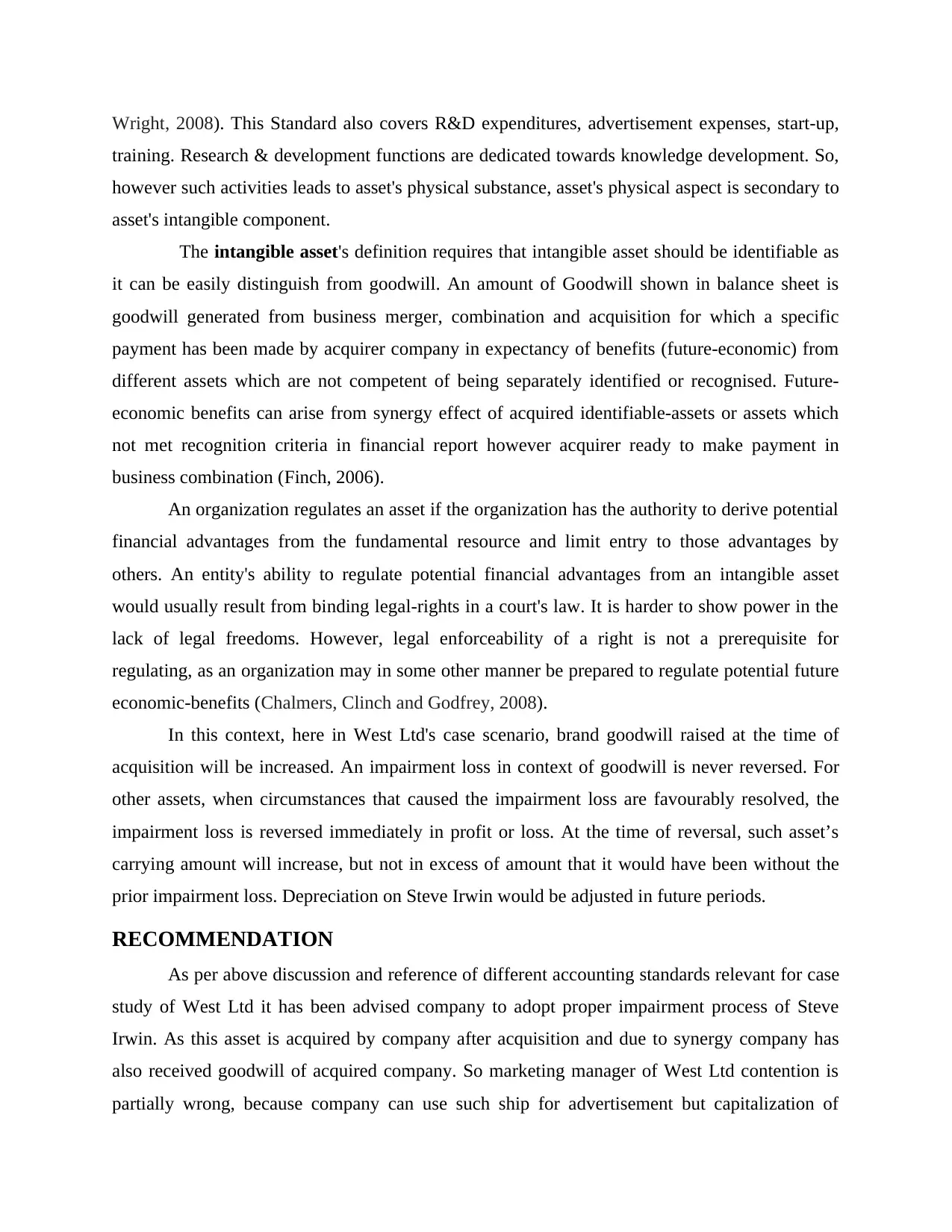
Wright, 2008). This Standard also covers R&D expenditures, advertisement expenses, start-up,
training. Research & development functions are dedicated towards knowledge development. So,
however such activities leads to asset's physical substance, asset's physical aspect is secondary to
asset's intangible component.
The intangible asset's definition requires that intangible asset should be identifiable as
it can be easily distinguish from goodwill. An amount of Goodwill shown in balance sheet is
goodwill generated from business merger, combination and acquisition for which a specific
payment has been made by acquirer company in expectancy of benefits (future-economic) from
different assets which are not competent of being separately identified or recognised. Future-
economic benefits can arise from synergy effect of acquired identifiable-assets or assets which
not met recognition criteria in financial report however acquirer ready to make payment in
business combination (Finch, 2006).
An organization regulates an asset if the organization has the authority to derive potential
financial advantages from the fundamental resource and limit entry to those advantages by
others. An entity's ability to regulate potential financial advantages from an intangible asset
would usually result from binding legal-rights in a court's law. It is harder to show power in the
lack of legal freedoms. However, legal enforceability of a right is not a prerequisite for
regulating, as an organization may in some other manner be prepared to regulate potential future
economic-benefits (Chalmers, Clinch and Godfrey, 2008).
In this context, here in West Ltd's case scenario, brand goodwill raised at the time of
acquisition will be increased. An impairment loss in context of goodwill is never reversed. For
other assets, when circumstances that caused the impairment loss are favourably resolved, the
impairment loss is reversed immediately in profit or loss. At the time of reversal, such asset’s
carrying amount will increase, but not in excess of amount that it would have been without the
prior impairment loss. Depreciation on Steve Irwin would be adjusted in future periods.
RECOMMENDATION
As per above discussion and reference of different accounting standards relevant for case
study of West Ltd it has been advised company to adopt proper impairment process of Steve
Irwin. As this asset is acquired by company after acquisition and due to synergy company has
also received goodwill of acquired company. So marketing manager of West Ltd contention is
partially wrong, because company can use such ship for advertisement but capitalization of
training. Research & development functions are dedicated towards knowledge development. So,
however such activities leads to asset's physical substance, asset's physical aspect is secondary to
asset's intangible component.
The intangible asset's definition requires that intangible asset should be identifiable as
it can be easily distinguish from goodwill. An amount of Goodwill shown in balance sheet is
goodwill generated from business merger, combination and acquisition for which a specific
payment has been made by acquirer company in expectancy of benefits (future-economic) from
different assets which are not competent of being separately identified or recognised. Future-
economic benefits can arise from synergy effect of acquired identifiable-assets or assets which
not met recognition criteria in financial report however acquirer ready to make payment in
business combination (Finch, 2006).
An organization regulates an asset if the organization has the authority to derive potential
financial advantages from the fundamental resource and limit entry to those advantages by
others. An entity's ability to regulate potential financial advantages from an intangible asset
would usually result from binding legal-rights in a court's law. It is harder to show power in the
lack of legal freedoms. However, legal enforceability of a right is not a prerequisite for
regulating, as an organization may in some other manner be prepared to regulate potential future
economic-benefits (Chalmers, Clinch and Godfrey, 2008).
In this context, here in West Ltd's case scenario, brand goodwill raised at the time of
acquisition will be increased. An impairment loss in context of goodwill is never reversed. For
other assets, when circumstances that caused the impairment loss are favourably resolved, the
impairment loss is reversed immediately in profit or loss. At the time of reversal, such asset’s
carrying amount will increase, but not in excess of amount that it would have been without the
prior impairment loss. Depreciation on Steve Irwin would be adjusted in future periods.
RECOMMENDATION
As per above discussion and reference of different accounting standards relevant for case
study of West Ltd it has been advised company to adopt proper impairment process of Steve
Irwin. As this asset is acquired by company after acquisition and due to synergy company has
also received goodwill of acquired company. So marketing manager of West Ltd contention is
partially wrong, because company can use such ship for advertisement but capitalization of
Paraphrase This Document
Need a fresh take? Get an instant paraphrase of this document with our AI Paraphraser
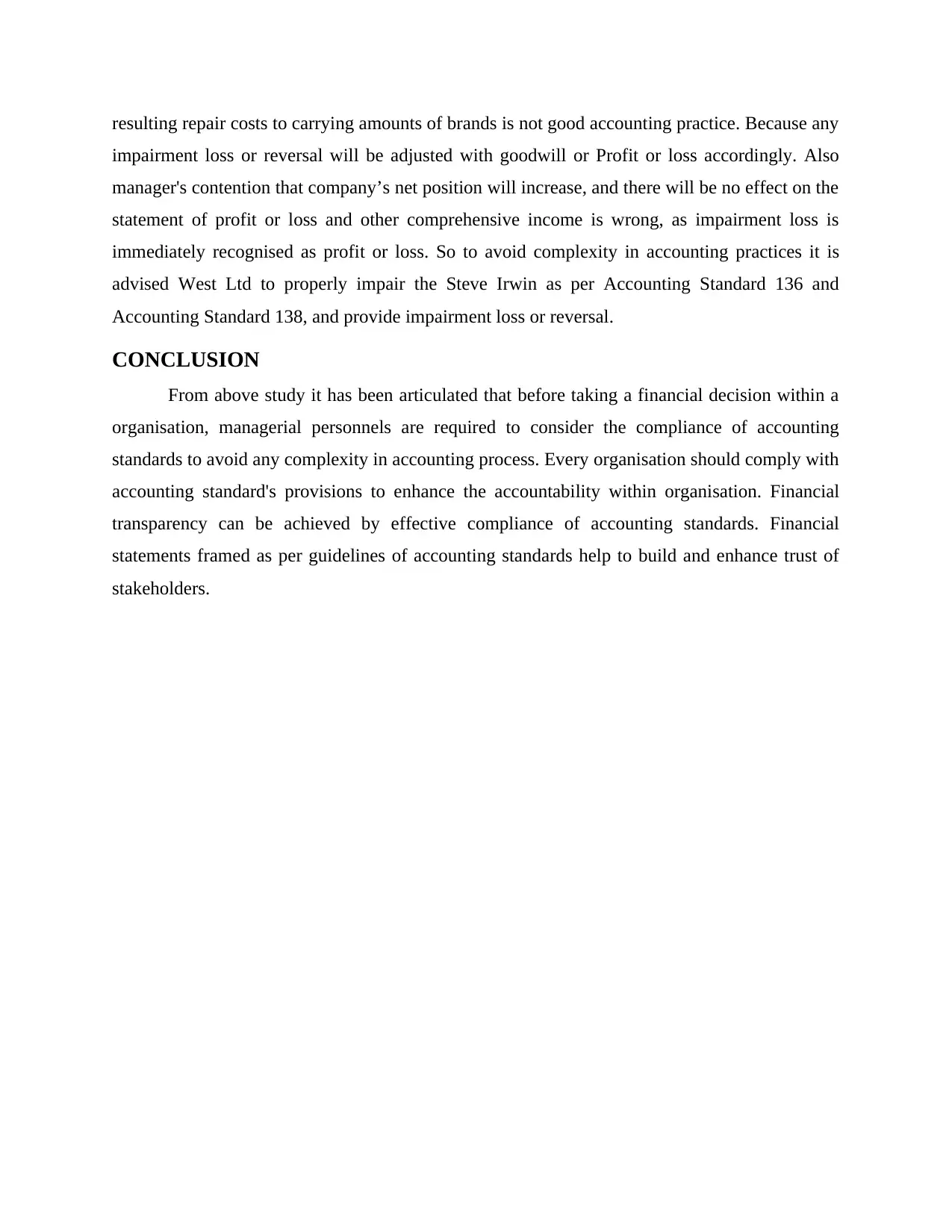
resulting repair costs to carrying amounts of brands is not good accounting practice. Because any
impairment loss or reversal will be adjusted with goodwill or Profit or loss accordingly. Also
manager's contention that company’s net position will increase, and there will be no effect on the
statement of profit or loss and other comprehensive income is wrong, as impairment loss is
immediately recognised as profit or loss. So to avoid complexity in accounting practices it is
advised West Ltd to properly impair the Steve Irwin as per Accounting Standard 136 and
Accounting Standard 138, and provide impairment loss or reversal.
CONCLUSION
From above study it has been articulated that before taking a financial decision within a
organisation, managerial personnels are required to consider the compliance of accounting
standards to avoid any complexity in accounting process. Every organisation should comply with
accounting standard's provisions to enhance the accountability within organisation. Financial
transparency can be achieved by effective compliance of accounting standards. Financial
statements framed as per guidelines of accounting standards help to build and enhance trust of
stakeholders.
impairment loss or reversal will be adjusted with goodwill or Profit or loss accordingly. Also
manager's contention that company’s net position will increase, and there will be no effect on the
statement of profit or loss and other comprehensive income is wrong, as impairment loss is
immediately recognised as profit or loss. So to avoid complexity in accounting practices it is
advised West Ltd to properly impair the Steve Irwin as per Accounting Standard 136 and
Accounting Standard 138, and provide impairment loss or reversal.
CONCLUSION
From above study it has been articulated that before taking a financial decision within a
organisation, managerial personnels are required to consider the compliance of accounting
standards to avoid any complexity in accounting process. Every organisation should comply with
accounting standard's provisions to enhance the accountability within organisation. Financial
transparency can be achieved by effective compliance of accounting standards. Financial
statements framed as per guidelines of accounting standards help to build and enhance trust of
stakeholders.
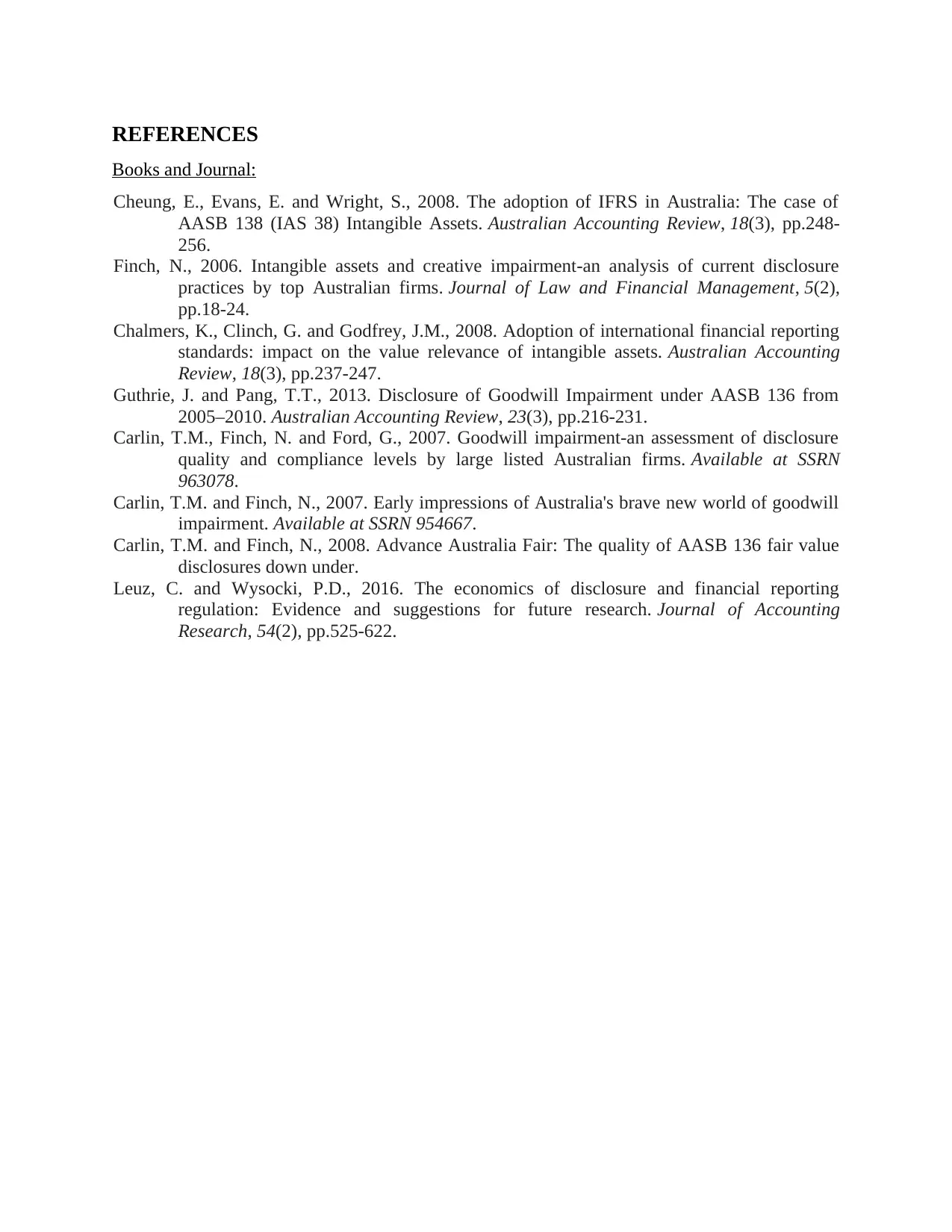
REFERENCES
Books and Journal:
Cheung, E., Evans, E. and Wright, S., 2008. The adoption of IFRS in Australia: The case of
AASB 138 (IAS 38) Intangible Assets. Australian Accounting Review, 18(3), pp.248-
256.
Finch, N., 2006. Intangible assets and creative impairment-an analysis of current disclosure
practices by top Australian firms. Journal of Law and Financial Management, 5(2),
pp.18-24.
Chalmers, K., Clinch, G. and Godfrey, J.M., 2008. Adoption of international financial reporting
standards: impact on the value relevance of intangible assets. Australian Accounting
Review, 18(3), pp.237-247.
Guthrie, J. and Pang, T.T., 2013. Disclosure of Goodwill Impairment under AASB 136 from
2005–2010. Australian Accounting Review, 23(3), pp.216-231.
Carlin, T.M., Finch, N. and Ford, G., 2007. Goodwill impairment-an assessment of disclosure
quality and compliance levels by large listed Australian firms. Available at SSRN
963078.
Carlin, T.M. and Finch, N., 2007. Early impressions of Australia's brave new world of goodwill
impairment. Available at SSRN 954667.
Carlin, T.M. and Finch, N., 2008. Advance Australia Fair: The quality of AASB 136 fair value
disclosures down under.
Leuz, C. and Wysocki, P.D., 2016. The economics of disclosure and financial reporting
regulation: Evidence and suggestions for future research. Journal of Accounting
Research, 54(2), pp.525-622.
Books and Journal:
Cheung, E., Evans, E. and Wright, S., 2008. The adoption of IFRS in Australia: The case of
AASB 138 (IAS 38) Intangible Assets. Australian Accounting Review, 18(3), pp.248-
256.
Finch, N., 2006. Intangible assets and creative impairment-an analysis of current disclosure
practices by top Australian firms. Journal of Law and Financial Management, 5(2),
pp.18-24.
Chalmers, K., Clinch, G. and Godfrey, J.M., 2008. Adoption of international financial reporting
standards: impact on the value relevance of intangible assets. Australian Accounting
Review, 18(3), pp.237-247.
Guthrie, J. and Pang, T.T., 2013. Disclosure of Goodwill Impairment under AASB 136 from
2005–2010. Australian Accounting Review, 23(3), pp.216-231.
Carlin, T.M., Finch, N. and Ford, G., 2007. Goodwill impairment-an assessment of disclosure
quality and compliance levels by large listed Australian firms. Available at SSRN
963078.
Carlin, T.M. and Finch, N., 2007. Early impressions of Australia's brave new world of goodwill
impairment. Available at SSRN 954667.
Carlin, T.M. and Finch, N., 2008. Advance Australia Fair: The quality of AASB 136 fair value
disclosures down under.
Leuz, C. and Wysocki, P.D., 2016. The economics of disclosure and financial reporting
regulation: Evidence and suggestions for future research. Journal of Accounting
Research, 54(2), pp.525-622.
⊘ This is a preview!⊘
Do you want full access?
Subscribe today to unlock all pages.

Trusted by 1+ million students worldwide
1 out of 9
Related Documents
Your All-in-One AI-Powered Toolkit for Academic Success.
+13062052269
info@desklib.com
Available 24*7 on WhatsApp / Email
![[object Object]](/_next/static/media/star-bottom.7253800d.svg)
Unlock your academic potential
Copyright © 2020–2026 A2Z Services. All Rights Reserved. Developed and managed by ZUCOL.





